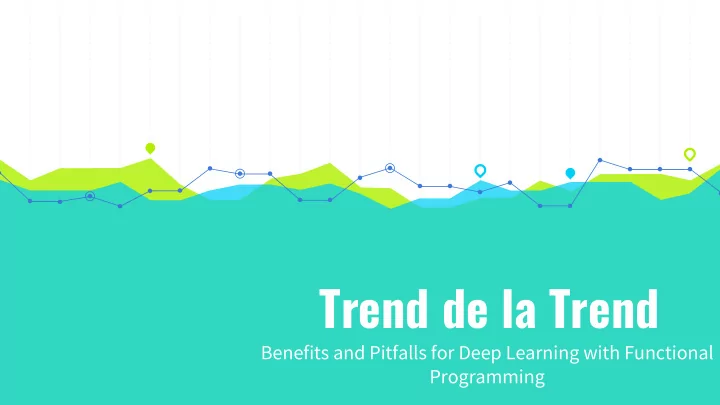

Trend de la Trend Benefits and Pitfalls for Deep Learning with Functional Programming
HELLO! I am Brad Johns I should write something here but I’m lazy. Here’s my github: https://github.com/bradjohns94
A Quick Intro to Deep Learning I’ll try to make this quick and painless
Perceptrons 4 Variables ◉ Inputs ◉ Weights ◉ Bias ◉ Activation Function Multiply the inputs by weights, add a bias, run it through the function. Easy.
Perceptrons - Example
Perceptrons - Example
Perceptrons - Example
Neural Networks Step 1: Take Some Perceptrons Step 2: Glue them together in layers Step 3: Profit
The “Learning” Part I’m sorry in advance
Backpropagation and Gradient Descent 1. Calculate the “Cost” (C) of the network by comparing actual vs. expected outputs 2. Determine the impact or “error” (δ L ) of each output neuron/perceptron on the cost 3. Find out how much each hidden layer contributes to the next layers error (δ l ) 4. Calculate how much each weight/bias contributes to the error of the associated neuron/perceptron ( ∂w and ∂b) 5. Adjust weights and biases according to their effect on the error
Wow. Code. (Scala)
Wow. Math.
The Important Bits We’ll get to the functional part soon - I promise
The Vanishing/Exploding Gradient Problem ◉ Errors for earlier layers are dependent on errors from later layers ◉ Errors tend to increase or decrease exponentially as you backpropagate ◉ When your errors are too big or too small you learn effectively nothing ◉ Deep Learning: a pile of hacks to fix this problem
Example Hack 1: Convolution ◉ Primarily used for image processing/other 2D data sets ◉ Don’t fully connect your way to the next layer ◉ Connect small squares of neurons to the next layer ◉ Pool outputs to estimate relative position
Example Hack 2: LSTMs ◉ Primarily used for NLP/other sequential data ◉ Feed the network back into itself recurrently ◉ Use special “forget” neurons to determine what data is important to remember ◉ Mostly magic
Getting on With it Functional Programming and Deep Learning
So What Was the Point of All That? ◉ Understanding the structure of Neural Nets and the Modularity of Deep Learning modules lets us see how functional programming plays well with it ◉ Understanding the structure of Neural Nets lets us look at how we can develop them functionally ◉ Knowing different implementations lets us explore what various technologies are good at ◉ You have some idea of how deep learning works now, so that’s cool I guess, right?
Things ML is Things FP is Concurrent Good at Good at Computing Maintaining Pure Math Lazy State Evaluation Modular CPU Design Intensive Operations Big Data Operations
So How Easy is Learning With FP?
And We’re Not Even Deep Yet! (Phrasing) ◉ The amazing thing about deep learning - every kind of layer is a new module ◉ Tiny tweaks to existing layers create new possibilities with the same formulas ◉ Deep learning modules like convolutional layers and LSTM modules rely on the same perceptron logic we’ve already designed ◉ Just add tweaks to activation functions and throw them together!
Case Study: Recurrent Neural Networks Because saying “Hey look, this is functional!” is boring
Yet Another Introduction Take a Neural Network, add a twist (literally) ◉ Same input/hidden/output layer structure as before ◉ Hidden layers have an additional set of inputs: their last outputs ◉ RNNs can keep track of state unlike traditional NN’s, but get deep fast ◉ Let’s make this a little less scary...
Recurrent NNs: Now With Less Magic!
Encoding: Something Old, Something New Encoding: Take a variable length input, encode it to one value Operationally: ◉ Input a value ◉ Pass hidden layer output to next iteration ◉ Take the last output the hidden layer Live Demo of Encodes with RNNs So… you know… a fold
And it Keeps Going! Encoding: Equivalent to Haskell foldl, Scala foldLeft Generation: Equivalent to Haskell unfoldr, Scala unfoldRight Standard RNN: Equivalent to Haskell mapAccumR, Scala no easy parallel
Finishing Up Some Things to Know and Some Credit to Give
The “Pitfalls” Part “Purer” functional languages have limited libraries: ◉ Scala - DeepLearning4Java (DL4J) ◉ Not technically scala - but java libraries are scala libraries ◉ Scala-specific port in alpha ◉ Not great and the support community isn’t much better ◉ https://deeplearning4j.org/ ◉ Haskell - Grenade ◉ Still in early development (0.1.0) ◉ Very young - basically no community ◉ https://github.com/HuwCampbell/grenade
Nobody Uses Pure RNNs - Use LSTMs (Out of nowhere, I know. But really)
Resources Deep Learning in General: ◉ http://neuralnetworksanddeeplearning.com/ ◉ Main source for the intro to DL stuff Deep Learning + Functional Programming and RNNs: ◉ http://colah.github.io/ ◉ Main source for RNN and FP stuff These guys are the best, please check them out
THANKS! Any questions? Code samples: https://github.com/bradjohns94/MNIST-From-Scratch
Helpful Images But Mostly Memes https://upload.wikimedia.org/wikipedia/commons/thumb/4/46/Colored_neural_network.svg/300px-Colored_neu ral_network.svg.png http://neuralnetworksanddeeplearning.com/images/tikz21.png http://media.boingboing.net/wp-content/uploads/2016/11/bcf.png https://media.tenor.com/images/191e856ae3d5ed9c280ff64c93164f55/tenor.gif https://media.tenor.com/images/08c127d137e22d56677a6b0deb321887/tenor.gif http://i.imgur.com/5JPp8NQ.gif http://colah.github.io/posts/2015-08-Understanding-LSTMs/img/RNN-rolled.png http://colah.github.io/posts/2015-08-Understanding-LSTMs/img/RNN-unrolled.png https://media.giphy.com/media/YIdO82g8zZfDa/giphy.gif
A Little More Because Stealing is Wrong http://colah.github.io/posts/2015-09-NN-Types-FP/img/RNN-encoding.png http://colah.github.io/posts/2015-09-NN-Types-FP/img/RNN-generating.png http://colah.github.io/posts/2015-09-NN-Types-FP/img/RNN-general.png http://colah.github.io/posts/2015-08-Understanding-LSTMs/img/LSTM3-chain.png
Recommend
More recommend